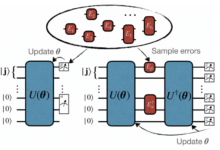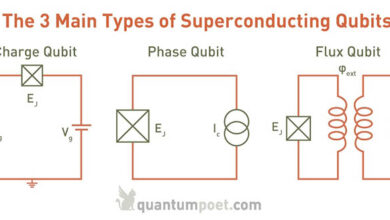Quantum Cryptography Securing the Future
Quantum cryptography leverages the bizarre laws of quantum mechanics to create unbreakable encryption. Unlike classical cryptography, which relies on complex mathematical problems, quantum cryptography uses the fundamental properties of quantum particles, like photons, to transmit secret keys. This revolutionary approach promises impenetrable security against even the most powerful future computers, including quantum computers themselves.
Its development stems from the groundbreaking work of several physicists and mathematicians, laying the groundwork for secure communication in an increasingly digital world. The core of quantum cryptography is Quantum Key Distribution (QKD), a process that allows two parties to securely share a secret key, enabling them to encrypt and decrypt messages without fear of eavesdropping. This involves exploiting the principles of quantum mechanics, such as superposition and entanglement, to detect any attempts to intercept the key exchange.
Introduction to Quantum Cryptography
Quantum cryptography leverages the bizarre yet fascinating principles of quantum mechanics to create secure communication systems. Unlike classical cryptography, which relies on computational complexity for security, quantum cryptography’s security is fundamentally rooted in the laws of physics. This makes it exceptionally resilient against attacks, even from hypothetical future computers with vastly superior processing power.Quantum cryptography fundamentally differs from classical cryptography in its reliance on quantum mechanical phenomena.
Classical cryptography relies on mathematical algorithms and the computational difficulty of breaking them. For instance, RSA encryption depends on the difficulty of factoring large numbers. Quantum cryptography, however, utilizes the properties of quantum states, such as superposition and entanglement, to guarantee secure communication. This shift from computational complexity to physical laws provides an unparalleled level of security.
Quantum cryptography promises ultra-secure communication, vital as we move towards a more interconnected world. This heightened security is especially important given the rapid growth of data transmission facilitated by the expansion of 5G network expansion , which increases both the volume and the potential vulnerability of data. Therefore, the development of quantum cryptography is a crucial step in safeguarding our increasingly digital future.
Fundamental Principles of Quantum Mechanics in Quantum Cryptography
Quantum cryptography hinges on several key principles of quantum mechanics. Superposition, where a quantum bit (qubit) can exist in a combination of 0 and 1 simultaneously, allows for the encoding of information in a way that any attempt to measure it inevitably alters the state. This forms the basis of detection of eavesdropping. Entanglement, where two or more qubits become linked and share the same fate regardless of the distance separating them, enables the creation of secure quantum keys.
The act of measuring one entangled qubit instantly influences the state of the others, providing a way to detect any tampering with the communication channel. The uncertainty principle, stating that certain pairs of physical properties, such as position and momentum, cannot both be known with perfect accuracy, further enhances the security of quantum cryptography. Any attempt to measure a qubit to gain information inevitably disturbs its state, alerting the legitimate parties to the presence of an eavesdropper.
Key Differences Between Classical and Quantum Cryptography
Classical cryptography, as previously mentioned, relies on computationally hard problems. Its security is based on the assumption that it’s computationally infeasible to break the encryption within a reasonable timeframe. Quantum cryptography, however, derives its security from the laws of physics. Even with unlimited computing power, certain attacks are fundamentally impossible due to the principles of quantum mechanics.
This difference is crucial. A sufficiently powerful quantum computer could break many widely used classical encryption algorithms, rendering current online security protocols vulnerable. Quantum cryptography offers a solution to this future threat.
Historical Overview of Quantum Cryptography
The theoretical foundations of quantum cryptography were laid in the 1970s and 1980s. Stephen Wiesner’s early work on conjugate coding, although not immediately recognized, provided some of the initial ideas. However, the field truly took off with the publication of Charles Bennett and Gilles Brassard’s paper in 1984, introducing the BB84 protocol, a pioneering quantum key distribution (QKD) scheme.
This protocol demonstrated the feasibility of using quantum mechanics to securely exchange cryptographic keys. Since then, significant progress has been made in both the theoretical understanding and practical implementation of quantum cryptography. Research continues to explore new protocols and improve the efficiency and robustness of existing ones, paving the way for widespread adoption of this groundbreaking technology.
Today, quantum cryptography is moving beyond theoretical research and into practical applications, with commercial systems becoming increasingly available.
Quantum Key Distribution (QKD)
Quantum Key Distribution (QKD) is a secure communication method leveraging the principles of quantum mechanics to establish a shared secret key between two parties. Unlike classical cryptography, QKD’s security is fundamentally guaranteed by the laws of physics, making it highly resistant to eavesdropping. This technology offers a promising solution for protecting sensitive information in the face of increasingly powerful computing capabilities that threaten classical encryption methods.
QKD Protocols: BB84 and E91
Several QKD protocols exist, each with its own strengths and weaknesses. Two prominent examples are BB84 and E91. BB84, developed by Charles Bennett and Gilles Brassard in 1984, is the most widely implemented protocol. E91, proposed by Artur Ekert in 1991, utilizes the entanglement of photon pairs to generate a secret key.
Quantum cryptography offers unparalleled security for data transmission, but its practical implementation faces challenges. The speed and low latency offered by the infrastructure described in this article on Edge computing and 5G could significantly improve the feasibility of quantum key distribution, enabling faster and more secure communication networks. This synergy between advanced cryptography and cutting-edge networking is crucial for future data security.
| Protocol | Mechanism | Strengths | Weaknesses |
|---|---|---|---|
| BB84 | Uses single photons polarized in different bases (rectilinear and diagonal) to encode bits. | Relatively simple to implement; widely used and well-understood. | Vulnerable to photon loss and requires high-quality single-photon sources and detectors. |
| E91 | Leverages entangled photon pairs; measurement of one photon’s state instantly determines the other’s state. | Potentially more secure against certain attacks; inherently generates a secret key. | Requires more complex experimental setup; more susceptible to noise and imperfections in the entangled photon source. |
The Role of Single Photons in QKD
Single photons are the fundamental building blocks of most QKD protocols. Their quantum properties, specifically their polarization, are used to encode information. The act of measuring a single photon’s polarization inherently disturbs its state, allowing the communicating parties to detect the presence of an eavesdropper. The uncertainty principle in quantum mechanics ensures that any attempt to intercept and measure the photons without detection will inevitably introduce errors in the transmitted data, alerting the legitimate users to the breach.
Security Advantages of QKD over Classical Key Exchange
Classical key exchange methods, such as RSA, rely on computational complexity for their security. This means their security is contingent on the difficulty of solving certain mathematical problems with current computing technology. However, advancements in quantum computing threaten to break these classical encryption methods. QKD, on the other hand, derives its security from the laws of physics, making it fundamentally secure against attacks even by quantum computers.
The detection of eavesdropping is inherent to the process, providing an immediate alert to the communicating parties.
Simplified Diagram of QKD
A simplified diagram of a QKD system would show two parties, Alice and Bob, connected by a quantum channel (e.g., an optical fiber) and a classical channel (e.g., a standard internet connection). Alice generates single photons with random polarizations, encoding bits of information. She sends these photons through the quantum channel to Bob. Bob measures the polarization of each received photon using a randomly chosen basis.
Alice and Bob then publicly compare their basis choices via the classical channel, discarding the results obtained using different bases. The remaining results form the raw key. Finally, Alice and Bob perform error correction and privacy amplification to refine the raw key into a final shared secret key, secure from eavesdropping. The diagram would depict Alice’s photon source, her polarization controllers, the quantum channel, Bob’s polarization detectors, and the classical channel connecting them.
Each component’s function would be clearly labelled.
Quantum Random Number Generators (QRNGs)
Quantum Random Number Generators (QRNGs) represent a significant advancement in cryptography, offering a level of randomness far exceeding that achievable with classical methods. Their reliance on the inherent unpredictability of quantum phenomena ensures a higher degree of security for cryptographic applications.QRNGs leverage the fundamental principles of quantum mechanics to generate truly random numbers. Unlike classical random number generators (CRNGs), which rely on deterministic algorithms and often exhibit patterns or biases, QRNGs exploit the probabilistic nature of quantum events, such as the decay of radioactive isotopes or the measurement of photons’ polarization.
This inherent randomness makes QRNG-generated sequences significantly more resistant to prediction and manipulation.
Comparison of QRNGs and CRNGs
Classical random number generators (CRNGs) use deterministic algorithms, meaning that given the same initial conditions (the “seed”), they will always produce the same sequence of numbers. While sophisticated algorithms can produce sequences that appear random, they are ultimately predictable if the algorithm and seed are known. This predictability poses a significant vulnerability in cryptography, particularly in scenarios where an attacker could potentially guess the seed or reverse-engineer the algorithm.
In contrast, QRNGs harness the inherent randomness of quantum mechanics, making their output truly unpredictable, even with knowledge of the underlying physical process. The unpredictability stems from the probabilistic nature of quantum events, which are governed by the laws of quantum mechanics and not by any deterministic algorithm.
Potential Vulnerabilities in QRNG Implementations
While QRNGs offer superior randomness, potential vulnerabilities exist in their practical implementations. One major concern is the possibility of systematic biases introduced by imperfections in the physical hardware used to generate the random numbers. For instance, subtle variations in the detection system of a photon-based QRNG could lead to a non-uniform distribution of generated bits. Another vulnerability arises from potential side-channel attacks, where an attacker might try to extract information about the generated sequence by observing the physical system’s behavior or energy consumption.
Careful design, rigorous testing, and post-processing techniques are crucial to mitigate these vulnerabilities and ensure the reliability and security of the generated random numbers.
Practical Applications of QRNGs in Securing Data
QRNGs find widespread applications in securing data across various domains. In cryptography, they are used to generate cryptographic keys that are highly resistant to attacks. The use of QRNGs in key generation significantly strengthens the security of encryption algorithms, making it exponentially harder for attackers to decipher encrypted data. Furthermore, QRNGs play a vital role in secure random sampling, ensuring unbiased data selection in various applications, from scientific simulations to financial modeling.
Quantum cryptography offers incredibly secure communication, virtually unbreakable by conventional methods. Its development is closely linked to advancements in high-speed data transmission, making it a key area of interest for 6G research and development , which aims to drastically increase network speeds and capacity. Ultimately, the security provided by quantum cryptography will be crucial for the reliable and trustworthy operation of future 6G networks.
The use of QRNGs in generating nonce values for authentication protocols further enhances the security of online transactions and digital communication. Examples include their use in securing online banking transactions, protecting sensitive data in cloud storage, and enhancing the security of IoT devices. The integration of QRNGs into hardware security modules (HSMs) provides a robust and tamper-resistant solution for generating and managing cryptographic keys, ensuring the confidentiality and integrity of sensitive data.
Quantum Key Distribution Infrastructure and Challenges
Deploying quantum key distribution (QKD) networks presents significant technological hurdles. While QKD offers unparalleled security, translating theoretical advancements into practical, large-scale implementations requires overcoming various obstacles related to infrastructure, cost, and the evolving threat landscape of quantum computing.Building robust and widespread QKD networks necessitates addressing several key challenges. These challenges are interconnected and influence each other, impacting both the feasibility and cost-effectiveness of QKD deployments.
Quantum cryptography offers incredibly secure communication, but its implementation requires robust networks. Efficient network management is crucial, and that’s where advancements like AI-driven network optimization come into play. These AI systems can optimize routing and resource allocation, ensuring the quantum network functions at peak efficiency, thereby supporting the widespread adoption of quantum cryptography.
The current state of the art in QKD technology means that solutions are often bespoke and not readily scalable.
Technological Challenges in Deploying QKD Networks
Implementing QKD networks faces significant technological challenges. The fragility of quantum states necessitates highly specialized and often expensive equipment, including single-photon detectors, low-noise optical amplifiers, and stable laser sources. Maintaining the integrity of the quantum channel over long distances is also a considerable obstacle. Signal attenuation and noise accumulation limit the achievable transmission distances, necessitating the use of quantum repeaters, a technology that is still under intensive development.
Furthermore, the integration of QKD systems with existing telecommunication infrastructures requires careful consideration to ensure compatibility and seamless operation. Finally, the need for secure and reliable classical communication channels to manage the QKD system and handle key management tasks adds another layer of complexity.
Factors Influencing the Scalability and Cost-Effectiveness of QKD Systems
Several factors significantly impact the scalability and cost-effectiveness of QKD systems. Addressing these issues is crucial for widespread adoption.
- Cost of Equipment: The high cost of specialized quantum components, such as single-photon detectors and quantum transmitters, currently limits widespread deployment. The cost of these components often significantly exceeds that of classical communication equipment.
- Transmission Distance Limitations: Signal attenuation and noise limit the maximum distance over which quantum communication can reliably occur. This necessitates the use of quantum repeaters, a technology that is still in its early stages of development, significantly increasing the complexity and cost.
- Security Vulnerabilities: While QKD offers strong theoretical security, practical implementations are vulnerable to side-channel attacks, which exploit imperfections in the hardware or software. Robust countermeasures need to be implemented, adding to the complexity and cost.
- Integration with Existing Infrastructure: Integrating QKD systems into existing telecommunication networks requires significant effort and investment. Compatibility issues and the need for specialized interfaces can hinder seamless integration.
- Maintenance and Management: The complex nature of QKD systems necessitates specialized maintenance and management expertise. This adds to the overall operational cost.
Infrastructure Requirements for Large-Scale QKD Deployment
Large-scale QKD deployment necessitates a multi-layered infrastructure. This includes not only the quantum communication layer but also supporting classical communication channels and key management systems.The infrastructure needs to support secure key distribution between multiple nodes, potentially across large geographical distances. This often involves deploying a network of quantum repeaters, which are necessary for extending the range of QKD systems.
Furthermore, secure classical communication channels are required for managing the QKD system, including authentication, key distribution management, and error correction. Specialized software and hardware are needed for monitoring the system’s performance and ensuring the integrity of the keys. Finally, robust security protocols are essential to protect the system from various attacks, including side-channel attacks and quantum computer-based attacks.
Potential Impact of Quantum Computing on the Security of QKD
The advent of powerful quantum computers poses both a threat and an opportunity to QKD. While quantum computers could potentially break widely used public-key cryptography algorithms, thus undermining the security of classical communication systems, they also offer the potential for developing more advanced QKD protocols and quantum-resistant cryptographic techniques. The development of fault-tolerant quantum computers capable of breaking widely used encryption algorithms like RSA and ECC remains a long-term challenge, but the threat is real and necessitates proactive measures to secure critical data and infrastructure.
Therefore, QKD, with its inherent security based on the laws of quantum mechanics, represents a crucial countermeasure against future quantum computer-based attacks. However, it’s important to note that QKD’s security relies on the assumption that the quantum devices used are perfectly functioning and not susceptible to side-channel attacks, which needs careful consideration in its implementation and monitoring.
Post-Quantum Cryptography and its Relation to Quantum Cryptography

Source: cryptoadventure.com
Quantum cryptography and post-quantum cryptography, while both addressing the threat of quantum computers to current cryptographic systems, employ fundamentally different approaches. Quantum cryptography leverages the principles of quantum mechanics to ensure secure communication, while post-quantum cryptography focuses on developing classical algorithms resistant to attacks from quantum computers. Understanding their differences and potential synergies is crucial for building a secure future in the face of advancing quantum computing capabilities.Post-quantum cryptography aims to create algorithms that are secure against both classical and quantum computers.
This is achieved by designing algorithms whose security relies on mathematical problems believed to be intractable even for quantum computers. In contrast, quantum cryptography uses the inherent properties of quantum mechanics, such as superposition and entanglement, to detect eavesdropping and guarantee secure key exchange. This means that instead of relying on the difficulty of a mathematical problem, quantum cryptography relies on the laws of physics to secure communication.
Comparison of Quantum and Post-Quantum Cryptography
Quantum and post-quantum cryptography offer distinct advantages and disadvantages. Quantum cryptography, while offering theoretically perfect security, faces practical limitations in terms of distance and cost. Post-quantum cryptography, on the other hand, offers more readily deployable solutions but their long-term security relies on unproven assumptions about the hardness of certain mathematical problems. The choice between the two depends heavily on the specific application and its security requirements.
Synergy Between Quantum and Post-Quantum Cryptography
Rather than viewing these two approaches as mutually exclusive, a synergistic relationship is emerging. Post-quantum cryptography can provide a bridge to the future, offering short-term solutions that can be seamlessly integrated with future quantum cryptography systems. For example, post-quantum algorithms can be used to protect data in transit until a fully deployed quantum cryptography infrastructure is in place. This approach allows for a phased transition, mitigating the risks associated with a sudden shift to a completely new cryptographic paradigm.
Furthermore, post-quantum cryptography could be used to secure the infrastructure supporting quantum key distribution, enhancing the overall security of the system.
Scenarios Favoring Quantum Cryptography or Post-Quantum Cryptography
Quantum cryptography is preferred in scenarios requiring the highest level of security, such as protecting sensitive government communications or financial transactions where the risk of compromise is exceptionally high. The theoretical unbreakability of quantum cryptography makes it an attractive option for these high-stakes applications, despite its current limitations in scalability and cost.Post-quantum cryptography is a more practical choice for applications where immediate deployment is crucial and perfect security is not an absolute requirement.
This includes securing everyday online transactions, protecting data at rest, and securing various network infrastructures. The relative ease of implementation and integration with existing systems makes post-quantum cryptography a viable solution for widespread adoption.
Advantages and Disadvantages of Each Approach
Understanding the strengths and weaknesses of both approaches is essential for informed decision-making in cybersecurity strategies.
- Quantum Cryptography:
- Advantages: Theoretically perfect security based on the laws of physics; Detection of eavesdropping attempts.
- Disadvantages: Limited range; High cost and complexity of implementation; Susceptible to side-channel attacks if not implemented perfectly.
- Post-Quantum Cryptography:
- Advantages: Relatively easier to implement and integrate with existing infrastructure; Various algorithms offer different trade-offs between security and performance.
- Disadvantages: Long-term security relies on unproven assumptions about the hardness of certain mathematical problems; Performance might be slower compared to current algorithms.
Applications of Quantum Cryptography
Quantum cryptography, while still emerging, is finding practical applications in various sectors where the highest levels of security are paramount. Its ability to leverage the fundamental laws of quantum mechanics to guarantee secure communication offers a significant advantage over classical cryptographic methods, which are increasingly vulnerable to attacks from powerful quantum computers. This section will explore some of the current and future applications of this groundbreaking technology.
Quantum Cryptography in Finance
The financial sector, with its constant flow of sensitive data, is an early adopter of quantum cryptography. Protecting transactions, account details, and trading information is crucial. Quantum Key Distribution (QKD) systems can secure communication channels between banks, financial institutions, and their clients, ensuring the confidentiality of financial data transmitted over networks. For instance, some banks are already using QKD to protect high-value transactions, reducing the risk of fraud and data breaches.
This enhanced security offers greater trust and stability within the financial ecosystem. The potential for future applications extends to securing high-frequency trading systems and protecting against sophisticated attacks aimed at manipulating financial markets.
Quantum Cryptography in Healthcare
The healthcare industry deals with highly sensitive patient data, subject to stringent privacy regulations. Quantum cryptography can provide a robust solution for securing the transmission of electronic health records (EHRs), medical images, and other sensitive information. Hospitals and clinics could use QKD to establish secure communication links between different departments, or even between different healthcare facilities, protecting patient privacy and ensuring the integrity of medical data.
The potential to prevent unauthorized access to patient records and sensitive medical research data is a significant advantage. Future applications could include securing telemedicine platforms and protecting the confidentiality of genetic data.
Quantum Cryptography in Government
Government agencies handle classified information, sensitive communications, and critical infrastructure data. The need for robust security is paramount. Quantum cryptography can protect government communications and secure networks from both external and internal threats. QKD can secure communications between government agencies, ensuring the confidentiality of sensitive information exchanged during national security operations. Furthermore, it can be used to protect critical infrastructure from cyberattacks.
Future applications may involve securing voting systems and protecting sensitive national databases.
Future Applications of Quantum Cryptography
Beyond these current applications, the potential future uses of quantum cryptography are vast. The development of quantum internet infrastructure will enable the widespread deployment of QKD, securing communications on a global scale. Furthermore, advancements in quantum computing itself might lead to the development of new quantum cryptographic techniques offering even stronger security guarantees. The integration of quantum cryptography with other security technologies could create a layered security approach, further enhancing overall data protection.
This includes applications in areas such as secure cloud computing, blockchain technology, and the Internet of Things (IoT), where security is often a major challenge.
Future Directions and Research in Quantum Cryptography
Quantum cryptography, while showing immense promise, is still a field brimming with exciting research avenues. Significant advancements are needed to realize its full potential for securing our increasingly digital world. This section will explore key research areas and their implications for the future of secure communication.
More Robust and Efficient QKD Protocols
Developing more robust and efficient Quantum Key Distribution (QKD) protocols is a central focus. Current QKD systems face limitations in terms of distance and security against various attacks. Research is actively pursuing improvements in several key areas. For instance, researchers are exploring the use of novel quantum states, such as entangled photons or squeezed light, to improve the performance and security of QKD systems, making them less susceptible to eavesdropping.
Another crucial area is the development of more efficient and cost-effective single-photon detectors, which are essential components of many QKD systems. Improvements in detector technology could lead to longer transmission distances and higher key rates. Furthermore, significant effort is dedicated to developing decoy-state protocols and other advanced techniques to better protect against various types of attacks. These advancements would make QKD more practical for widespread deployment.
Integration with Existing Security Technologies
Integrating quantum cryptography with existing classical security technologies is a major challenge and opportunity. Simply replacing existing systems with quantum ones isn’t always feasible or practical. Instead, a hybrid approach, leveraging the strengths of both classical and quantum methods, is likely to be more effective. This hybrid approach could involve using quantum cryptography to secure the most sensitive parts of a system while employing classical cryptography for less sensitive data.
For example, QKD could be used to establish a secure channel for exchanging encryption keys, which are then used to encrypt bulk data using classical algorithms. Research in this area focuses on developing protocols and frameworks for seamless integration, ensuring interoperability and efficient resource utilization. This also involves addressing compatibility issues and developing standardized interfaces for seamless interaction between quantum and classical security systems.
Challenges and Opportunities in Device-Independent QKD
Device-independent quantum key distribution (DIQKD) represents a significant step towards enhancing the security of QKD. Unlike standard QKD, DIQKD doesn’t rely on assumptions about the internal workings of the devices used. This drastically reduces vulnerabilities to side-channel attacks, where an attacker exploits imperfections in the devices to gain information about the key. However, DIQKD protocols are currently more complex and less efficient than standard QKD.
Research is focused on improving the efficiency and practicality of DIQKD, exploring new protocols and techniques to reduce the resources required for secure key distribution. This includes investigating novel quantum states and measurement techniques to improve the efficiency of DIQKD protocols, and developing more robust error correction and privacy amplification techniques. The successful development of practical DIQKD systems would greatly enhance the trustworthiness and security of quantum cryptography.
Current Research Trends and Their Potential Impact
| Research Trend | Focus | Potential Impact | Example/Case |
|---|---|---|---|
| Improved Single-Photon Detectors | Developing more efficient and cost-effective detectors | Increased QKD range and key rates | Development of superconducting nanowire single-photon detectors (SNSPDs) leading to improved sensitivity and efficiency. |
| Development of Novel Quantum States | Exploring entangled photons and squeezed light for QKD | Enhanced security and performance | Use of hyperentanglement to encode more information per photon, increasing key rates. |
| Hybrid Quantum-Classical Cryptography | Integrating QKD with existing classical security systems | Practical and scalable solutions for real-world applications | Using QKD to secure key exchange for a financial transaction system, while employing classical encryption for bulk data. |
| Device-Independent QKD (DIQKD) | Developing DIQKD protocols that are robust against device imperfections | Unconditional security against side-channel attacks | Research on loop-hole-free Bell inequality tests for the implementation of DIQKD. |
Last Recap
Quantum cryptography represents a paradigm shift in secure communication, offering a level of protection previously unattainable. While challenges remain in scaling QKD infrastructure and cost-effectiveness, ongoing research and development are steadily addressing these issues. The potential synergy between quantum cryptography and post-quantum cryptography further strengthens the future of secure data transmission, paving the way for a truly secure digital age where sensitive information is safeguarded against both present and future threats.
The ongoing exploration of quantum mechanics promises even more sophisticated and robust methods for securing our digital lives.
General Inquiries
What is the biggest limitation of current QKD technology?
The biggest limitation is the relatively short distance over which photons can travel reliably. Current systems often require repeaters, which introduce vulnerabilities.
How does quantum cryptography differ from post-quantum cryptography?
Quantum cryptography uses quantum mechanics for security, while post-quantum cryptography uses classical algorithms believed to be resistant to attacks from quantum computers.
Are there any ethical concerns surrounding quantum cryptography?
Yes, potential concerns include the concentration of power in those who control quantum cryptography infrastructure and the potential for misuse by governments or malicious actors.
What is the role of entanglement in QKD?
Entanglement allows for the instantaneous correlation of two or more quantum particles, even when separated by vast distances. This property is exploited in some QKD protocols to detect eavesdropping.









